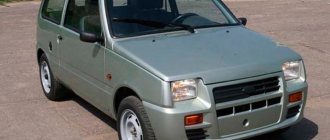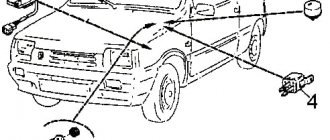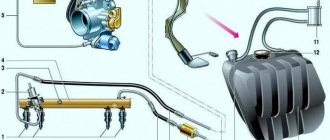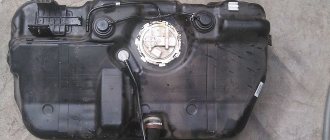The subcompact model "OKA" was first released by AvtoVAZ in 1988 and, as planned by the designers, it was supposed to be a mass-produced car in the USSR. However, until 1994, only small batches were released onto the market, and since 1995, assembly was transferred to the facilities of the KamAZ and SeAZ concerns. Here Oka experienced greater success - production volumes increased, and since 1998, these cars also began to be exported abroad.
Due to the high difference in exchange rates, the car cost little abroad. A little later, the outdated design of the body and power unit took its toll, which led to a decline in interest in the Oka since the 2000s. By 2008, the car was completely driven out of the market by foreign analogues and its production was discontinued. Let's try to understand the fuel consumption parameters of Okoya.
Information from the manufacturer
The total circulation of VAZ-1111 cars produced was 760-800 thousand copies. Oka gained popularity among the population due to its comfortable interior for 4 people and a spacious trunk. People liked the dynamics - it was a fast and maneuverable car, with low fuel consumption. The last factor also allowed us to save good money on gasoline. Let's figure out how much.
Officially, the manufacturer declares the following data on gasoline consumption for the VAZ 1111 OKA model, indicated in the technical documentation. Fuel consumption for OKA:
| Engine power, hp | Engine volume, l | Transmission type | Fuel consumption per 100 km, l | Fuel type |
| 30 | 0,7 | Manual transmission | 4,7-4,9 | Unleaded gasoline AI-92 |
| 33 | 0,8 | Manual transmission | 6,8-7,1 | |
| 53 | 1,0 | Manual transmission | 5,5-5,9 |
The manufacturer guaranteed the following fuel consumption values for various vehicle operating modes:
- Driving outside the city, on highways – 5.2-5.6 l;
- Driving around the city in busy traffic - 6.3-6.8 l;
- Trips around the city and intercity – 6.0-6.5 l;
- At idle – 0.5-0.8 l;
- When driving on dirt roads - 7.7-7.9 liters.
Conversion of hatchback 1111 Oka from gasoline to gas Gas consumption of VAZ 1111 Oka after installing LPG
Based on the gasoline consumption data for 3 trim levels of the 1111 Oka, we calculate the gas consumption. Let's calculate how much cheaper gas filling is. How many kilometers will the 1111 Oka travel without refueling?
Let's see how much gasoline is consumed in liters per hundred kilometers by 3 types of VAZ 1111 Oka engines produced from 1987 to 2008, which are equipped with 3-door hatchbacks.
Gasoline costs
| Volume | Transfers | Gasoline type | Gasoline consumption by road type | Price of 1000 km of gasoline, mixed mode | ||
| In the city | On the road | Mixed | ||||
| 0.6 | Mechanics | 92 | 8.2 | 4.8 | 6.4 | |
| 0.7 | Mechanics | 92 | 8.2 | 4.8 | 6.4 | |
| 0.7 | Mechanics | 95 | 8.2 | 4.8 | 6.4 | |
| Consumption in liters per 100 km. Gasoline price in rubles per liter: 92 - 45.00 RUR, 95 - 47.00 RUR. | ||||||
Real fuel consumption
The figures for actual fuel consumption differed from those indicated in the passport. The first versions of the VAZ 1111 were equipped with a 0.7-liter power plant that developed a power of 30 horses. Owners write that this variation consumes 6.4-6.5 liters in the city, and on the highway the value is 4.8-5.0 liters.
In 1995, the Oka chassis was modernized and a new engine with a cylinder capacity of 0.8 liters was installed (it produced 33 hp). This power plant turned out to be the most “gluttonous”, requiring from the owner 7.2-7.5 liters in the urban cycle and 5.0-5.4 liters per 100 kilometers on intercity routes.
The latest variation of the OKI is with a 1.0 liter engine, which gives the car 53 horses. It was also distinguished by its efficiency, consuming 6.0-6.4 liters in city traffic, and 4.4-4.7 liters when driving on the highway.
Speed characteristics of a minicar
When driving outside the city, the Oka is quite capable of accelerating to 110 km/h, however, as the owners note, the ride becomes quite uncomfortable. The steering wheel tries to jump out of your hands, you have to constantly squeeze it very tightly. The suspension senses the slightest unevenness in the road surface and instantly transmits them to the driver’s “fifth point.” This is not surprising; with such small wheels (12 inches), it is simply impossible to drive through the pits in any other way.
Users named another drawback as the difficulty in finding spare parts when making repairs, and this machine breaks down quite often. Today, such minicars are no longer produced, and therefore sales of parts have stopped. Of course, in such cases it is much easier for a Russian car enthusiast than for a foreigner caught in a similar situation. Our craftsmen themselves have learned to make spare parts needed for repairs, but it is not always possible to find and process truly high-quality metal. Therefore, long-manufactured parts rarely last.
Continuing the topic of shortcomings, it is worth mentioning that the first breakdowns for the owners began after only a year and a half of operation, and everything began to “crumble” at once. The biggest problems were caused by ruptures in the stove pipes and thresholds that were not resistant to corrosion. Those who were particularly unlucky with the body had to digest them twice a year. However, in fairness, it is worth noting that if the owner was meticulous and closely monitored the car, the Oka was capable of driving up to 100,000 km. There are quite a lot of such cars on Russian roads now. And they run quite briskly.
Oka 0 7 mt
The first versions of the VAZ 1111 were equipped with an engine that had a volume of 649 cubic meters. see also carburetor fuel dosing system. It featured two cylinders, which in total produced a power of 30 horses and a torque of up to 45 Nm. Only a mechanical transmission was provided. Owners write about the following consumption indicators for Okoy:
- Urban cycle - 5.1-6.8 l;
- On the highway – up to 10 liters (with aggressive driving);
- If you drive both in the city and on the highway – 7.5-8.1 liters.
Body. Tools and materials
| Do-it-yourself Oka 11113 carburetor adjustment With the constant increase in the cost of gasoline at Russian gas stations, which has been observed for quite some time, every motorist has thought at least once about how economical small cars can be. The carburetor that is installed on an OKA car is designed to solve the same problems as similar devices that are used on other models of passenger cars. |
| What is the fuel consumption of the Oka and on what factors does it depend? Continuing the topic of shortcomings, it is worth mentioning that the first breakdowns for the owners began after only a year and a half of operation, and everything began to crumble at once. The small car Oka, developed in 1988 at VAZ, was supposed to become one of the most popular cars before the collapse of the USSR, but until 1994 it was produced in small batches, and since 1995 production was completely transferred to KamAZ and SeAZ. |
- Andrey, Vladimir. I have a 2002 Oka with a 0.75 liter engine. For the money, the car is not bad, but when compared with others, it loses to everyone. There are simply zero amenities in the cabin, it constantly breaks down, although spare parts are very cheap and cost pennies. Over the course of a couple of years, I replaced four bumpers – repairing them is not an option at all, only replacing them. Consumption in the city is 7.5 liters - I’m surprised, I thought it would be much less.
- Evgeniy, Kursk. The car was made in 1997, naturally I took it second-hand, with a mileage of more than 60 thousand km. At the same time, the car stood in the garage for almost 6 years - naturally, I had to change all the gaskets, rubber bands, etc., and fill in technical fluids. The problem was with the wiring - it kept melting. Nevertheless, it is quite unpretentious and easy to maintain, but the consumption is high, as for a 0.75 liter engine - approximately 7-7.5 liters in the city, 6.5 liters on the highway.
- Kirill, Ufa. Considering that the engine in my Oka is half of the figure-eight engine that is installed on the VAZ-21083, I can’t understand why it consumes so much gasoline. The actual consumption is within 7 liters, my friend has a VAZ-21083, so that one consumes 8-9 maximum.
- Dmitry, St. Petersburg. The main advantage of Oka is its compact dimensions. It looks like there's no room, but there's actually plenty of space, especially for the driver and front passenger. Of course not at the back, but that's not a problem. Plus you can park wherever you want - for St. Petersburg this issue is acute. Consumption in the city is about 7-8 liters, but it pulls surprisingly well, you can even overtake.
- Vladimir, Orel. I owned the VAZ-1113 Oka for almost 4 years. At the time of purchase, the mileage was 45,000 km, the car was owned by a retired grandfather, who drove it once every five years. The advantage of the car is its size and the 0.75 liter engine, which is high-torque for its volume. Everything else needs to be improved - the steering, suspension and so on have been redone. Well, the weak metal of the body began to rot very quickly, even though I cooked it.
Oka 1.0 • 5 l, and is generally undemanding when it comes to the quality of gasoline.
Oka 0 8 mt
This modification was released in 1995; it was based on the successful design of the VAZ-21083 engine, adapted for a small car. The injection system was equipped with a carburetor, the cylinder volume was 750 cc. cm. All this made it possible to develop a power of 35 horses and a torque of 52 N*m. Transmission – only mechanics. As for fuel consumption, these were the highest values:
- In city traffic jams - 7.1-7.6 l;
- When traveling intercity - 6.4-6.6 l;
- If you drive both on the highway and in the city – 6.9-7.5 liters.
The latest cars converted to gas - A little history
| What is the consumption of an eye? In the front seats, the seating position is comfortable even for people with taller than average height, however, the pedals are located further to the right than the standard location in a passenger car; for a driver accustomed to the usual position, the clutch will be exactly under the right foot. But the outdated design of the body and power unit did not allow the car to successfully compete with higher quality and reliable foreign analogues in the early 2000s, so its production was discontinued in 2008. |
| VAZ 1111 fuel consumption It was in 2008, I needed wheels, but there was no money, so I took the Oka, which at that time cost me something like 300, just ridiculous money. In 1995, on the basis of the fairly successful VAZ-21083 engine, a stripped-down two-cylinder version of the VAZ-1113 was developed, which was equipped with the Oka car. |
- in the city – 6.3 liters;
- on the highway - 4.5 liters;
- mixed cycle - 5 liters.
Oka 1 0 mt
This was the last modernization in the history of OKI. Its production was launched at SeAZ facilities in 2006. Among the innovations, they began to install a Chinese-made power plant with a volume of 1000 cc. It was a powerful and economical engine that produced 53 horsepower with a torque of 77 N*m. The cars were equipped with a 5-speed manual transmission.
This variation showed the lowest gasoline consumption in the entire VAZ 1111 model range:
- On city streets - 6.4-6.8 l;
- When traveling intercity - 4.6-5.1 liters;
- In the mixed cycle - 5.8-6.1 liters.
Do-it-yourself Oka 11113 carburetor adjustment
The Oka carburetor was created on the basis of the Weber carburetor, which was well known to Zhiguli owners before 1980. The main differences are different diameters of the jets, the installation of an electromagnetic shut-off valve, as well as a number of devices related to the transverse arrangement of the Oka engine.
Compared to the Zhiguli, the Oka carburetor is actually rotated 90°: if you look at the car’s direction, the float chamber is on the right, and the mixing chambers are on the left. Therefore, during a sharp left turn, there is an “ebb” of gasoline from the main fuel jets 16 and 23 (Fig. 1) and econostat tube 17. The “ebb” is sometimes so significant that jerks and dips appear in the engine’s operation. That is why the fuel level in the float chamber of the Oka carburetor should be monitored especially carefully, preventing it from falling.
(!)
The nominal level is -22 mm from the carburetor cover gasket (with the cover removed).
Excessive increase in fuel level also leads to unstable engine operation. Please note that in the float chamber of the Oka carburetor there is an inertial economizer tube 12 (see Fig. 1). This device is designed to compensate for tidal phenomena.
The fuel level should be below the end of this tube. If the tube is lowered into gasoline, then the inertial economizer is constantly turned on, enriching the mixture in all modes, up to over-enrichment, as a result of which the engine can stop. At the nominal fuel level, the economizer will operate only during the “outflow” of gasoline from the main jets.
To check the fuel level in the Oka carburetor, it is easy to make the device shown in Fig. 2. Fitting 3 is screwed in instead of one of the plugs 14 (see Fig. 1). Tube 2 (see Fig. 2) is preferably made of glass or transparent petrol-resistant plastic. If the upper end of the tube is made 5 mm higher than shown in the figure, then the fuel level in the float chamber can be constantly monitored. You just need to take care of the tightness of the threaded connections and the strength of the measuring tube.
Rice. 2. Device for checking the fuel level in the float chamber of the Oka carburetor: 1 - gasket between the cover and the body; 2 - measuring tube; 3 - fitting.
(!)
The starting device of the Oka carburetor (Fig. 3) is similar to the same mechanism of Solex-type carburetors (installed on the VAZ-2108, -2109). By pulling out the “choke” coin, we turn lever 10 clockwise, while the curved surface “a” acts on the adjusting screw 12 and lever 13, slightly opening the throttle valve 11 of the first chamber. At the same time, the expanding groove between the internal profiles “b” and “c” of the lever 10 releases the pin of the lever 3, and the air damper 2 is closed under the action of the return spring 1. After starting the engine, the vacuum from the throttle space through channel 5 (see Fig. 1) affects diaphragm 5 (see Fig. 3) and using lever 4 slightly opens the air damper. The amount A of the damper slightly opens can be adjusted with screw 7 (see Fig. 3).
When checking the values of the starting gaps A and B (see Fig. 3), we pull the “suction” coin all the way, as a result of which air damper 2 should be completely closed. We pull the rod 4 until it stops against the screw 7 and measure the size of the gap A: it should be in the range of 2.0-2.4 mm. Now let’s pay attention to the size of the gap B: with the “suction” fully extended, its size should be 0.7-0.8 mm. This value is adjusted with screw 12 (see Fig. 3).
Owner reviews on gasoline consumption
Alexander from Irkutsk. I am the owner of a VAZ 1111 (Oka) produced in 1993. Of course, the appearance is not very nice, but I like the reliability and performance. Light weight, powerful engine. As for consumption, in the city I get 5.2-6.8 liters per hundred, and on the highway up to 10, if I drive hard.
Maxim from Oboyan. I bought a used OKU in 1997 with a 0.8 liter engine and a mileage of 50 thousand. Replaced all consumables, slightly repaired the suspension and made the car look like new. Consumption in the city is a bit high – 7.1-7.8 liters, and on the highway it’s a liter less.
Stanislav from Yalta. Inherited OKA 11113 with a Chinese liter engine. The car is not serious, but it is enough for trips to the country and occasional transportation of small cargo. Probably the only plus is consumption: it consumes 6 liters in the city, and 5.5 on the highway.
Popular on the site
Currently commenting:
I also want to know
Mazda, but not diesel, 2.5l.
Ford Kuga 2+. The best ratio of price, quality, options, reliability. At maximum 17 years old
The sound is also possible in the dashboard. Appears only when moving. So lean your ear
For example? Which new one up to 1.1 is better than all of the above?
Hello. Tell me, how is the price of a car formed over time? For example,
Agree. But if people have a dacha, relatives do not live very close, then a car is good
Do THAT and ride with God.
Automotive website Wroom.ru
Media registration certificate No. FS 77-76203 16+











